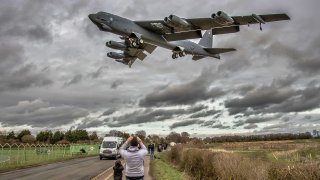B-52 Stratofortress Bomber Is Ancient But Looks Unstoppable
The B-52 Stratofortress, the longest-serving aircraft in U.S. military history, first took to the skies in 1952, a year marked by significant global and cultural events. And, somehow, this old bomber just keeps flying.
Summary: The B-52 Stratofortress, the longest-serving aircraft in U.S. military history, first took to the skies in 1952, a year marked by significant global and cultural events. Originally designed to operate alongside aircraft that have long been retired, the B-52 remains active 71 years later, now flying with modern jets like the F-22 and F-35. Despite its age, the B-52 has undergone numerous upgrades, maintaining its role thanks to its strategic design features like swept wings, podded jet engines, and a unique stabilization system. With a potential service life extending into the 2050s, the B-52 stands as a testament to enduring engineering and strategic relevance.
The B-52 Stratofortress: Celebrating 71 Years of Legendary U.S. Military Service
The longest-serving aircraft in the history of the U.S. military is the B-52 Stratofortress – and she’s still performing today, 71 years after her first flight.
The world was a very different place when the B-52 first flew. In 1952, Harry S. Truman was president, then Dwight D. Eisenhower won the presidential election. The Korean War raged. An American in Paris won the Academy Award for Best Picture. Wernher von Braun published an article titled “Man Will Conquer Space Soon!” The New York Yankees defeated the Brooklyn Dodgers in the World Series. The US tested the first hydrogen bomb. 58,000 cases of polio were reported in the U.S. Jimmy Boyd’s I Saw Mommy Kissing Santa Claus sold three million records.
In 1952, jet technology was less than a decade old. Aviation itself was less than half a century old. And the Air Force was unveiling its brand new long-range, subsonic strategic bomber, the B-52, to serve alongside airframes that have long since been retired, like the C-124 Globemaster, B-26 Invader, and F-80 Shooting Star.
That the B-52 is still serving today, now alongside the F-22, the F-35, and remotely piloted aircraft, is fairly remarkable. The world has changed since the B-52 first flew, and aviation has changed as well. The B-52 has gotten its fair share of upgrades through the years, but in many respects the bomber is still the same airframe that rolled off the assembly line 70 years ago, when Boeing built 744 of their new bombers.
Designed for Longevity
The B-52 shares many technological features with the B-47 Stratojet, which was retired in 1977. Both bombers used swept wings, podded jet engines, and crew ejection systems. In early B-52s, structural fatigue was an enduring problem, and it was shown to accelerate by a factor of eight in low-altitude profiles relative to high-altitude profiles. To ease the structural fatigue issues, the B-52 was enrolled in a three-phase program known as High Stress.

As the B-52 is a subsonic strategic bomber, its mission parameters called for only modest flight maneuvers, without the need for spin recovery. Thus the B-52 was built with a small and narrow rudder, which allowed for only limited yaw control authority. One reason the B-52 could get away with such a narrow rudder was its eight engines. Asymmetrical thrust resulting from the loss of an engine was minimal, and required minimal rudder inputs to correct. Similarly, the B-52 uses a narrow elevator, resulting in limited elevator control authority. To compensate, the B-52 uses a stabilator (an all-moving tail).
The B-52 is a lumbering brute – one that has performed its simple job efficiently enough to warrant continued service. In all, the B-52 measures 159 feet long, with a 185-foot wingspan and 40-foot height. The bomber’s wing area covers 4,000 square feet. The max takeoff weight is 488,000 pounds. The fuel capacity is 47,975 gallons.
The B-52 can reach 650 miles per hour, but it cruises at 509 mph, within a service ceiling of 50,000 feet.
Expect the storied bomber to continue serving until the 2050s, at which point the B-52 will be one century old.
About the Author: Harrison Kass
Harrison Kass is a defense and national security writer with over 1,000 total pieces on issues involving global affairs. An attorney, pilot, guitarist, and minor pro hockey player, Harrison joined the US Air Force as a Pilot Trainee but was medically discharged. Harrison holds a BA from Lake Forest College, a JD from the University of Oregon, and an MA from New York University. Harrison listens to Dokken.


